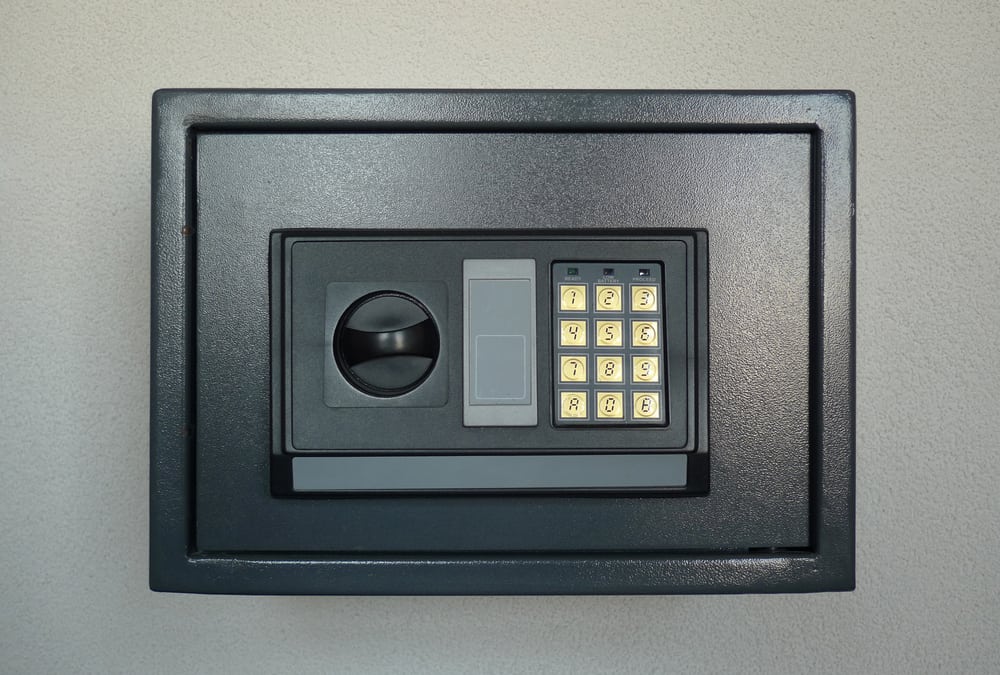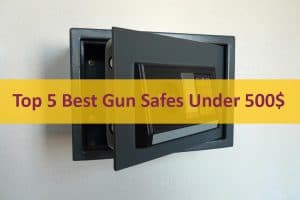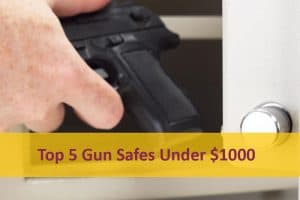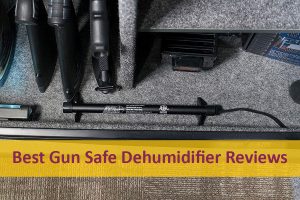Gun Safe 101: Definitive 2021 Buying Guide

Gun ownership is a big responsibility. There are a lot of things to consider to make sure you are a responsible and safe gun owner. For example, many homeowners think the safest thing to do is leave a loaded gun nearby while they sleep. This is ridiculously unsafe. Not only does it leave you vulnerable to your kids accidentally shooting each other because they want to play with the adult toy, it also means any stealthy invader could take it before you realized they were near. Also, it makes you feel invincible, when reality is that in most home invasions and close combat scenarios, the gun is easily twisted and used against you.
The safest way to keep a gun in the home is to store your unloaded gun in a gun safe and keep the ammo nearby. This prevents kids from getting it, intruders from getting it, and you from ending up in an even more dangerous situation if you’re not extremely well trained on how to use firearms in actual combat.
This guide is designed to help you understand gun safes. We will teach you some basics and help you find the right features for your needs. Once you finish, you will be able to shop around for a gun safe with confidence, knowing that you are fully informed and up to speed on anything you might need.
What’s a Safe?
This question is important to define for anyone who is first looking into gun safe purchases. Anyone can slap a lock on a box and call it a safe, but is it? How do you know it’s really safe?
Also, there are so many different types of safe it can be overwhelming trying to figure out which direction to go. Do you just want a box with a lock that is easy to access but keeps kids out? Or, do you want a safe deposit box at a bank – extremely secure but also inconvenient to access? The middle ground is what most of you are looking for. These are heavy, steel lockboxes – the thing that probably comes to mind when you hear the words gun safe.
For the purposes of this article, we are going to focus on what the industry calls Residential Security Containers (RSCs). The safe industry has a pretty good standard of quality, set forth by the Underwriter Laboratories. Underwriter Laboratories is an independent testing agency the industry uses. Their RSC certification marks a minimum standard of quality for residential gun safes. If a safe isn’t UL rated as an RSC, do not even bother purchasing it.
Basic Questions
Here’s the first and most basic question to ask: What are you trying to protect? What guns do you have and how many? How valuable are they? Are they collectibles, irreplaceable family heirlooms, or just hunting tools?
The follow up question is: Who and what are you trying to protect them from? Are you worried about keeping small children away from guns, but otherwise okay? Are your collectibles valuable enough to be targets and you want to keep the criminals from taking them?
Primary Considerations
There are some major categories of consideration when it comes to gun safe purchasing. Let’s take a look at the groups and discuss some of the important points in each.
Security

The reason most people buy gun safes is for security. You want to make sure your guns are safe and secure. Reflect back on our basic questions to determine the level of security you will need, as it will be different for each buyer. Knowing whether you’re trying to keep kids out or protect against curious visitors, whether you’re worried about theft because of your isolated location, or unconcerned about break ins, there is a safe out there that is right for you.
A good question to ask when considering purchases and comparing safes is how long it takes to break into it. This will give you an idea of how secure your safe is. Another good rule of thumb is that the heavier a safe is the harder it is to break into… as long as it is properly secured and bolted down so that it can’t be tipped over.
An important security feature on any safe is the lock. There are 2 main types of locks, digital and dial. A digital lock has an electronic code that you punch in to open the safe, and a dial needs to be manually spun. There are ups and downs for each of these. At the end of the day, neither option is better or worse than the other, so it really is preference on old school versus new tech.
With a digital lock, you will have to remember to change the batteries. However, if this doesn’t concern you, they are much easier to open, so you can get to your guns faster in emergencies, and easier to reprogram if you ever need to change the combination.
With a dial lock, you never need to worry about power sources or running out of batteries. They’re also a bit harder to hack than digital. However, they will take longer to open so you won’t get to your guns as quickly in emergencies, and they take longer to change the combination.
Weather Resistance
Another reason people buy gun safes is to protect them the same way you would important documents. A massive number of homeowners have waterproof, fireproof mini safes to store important paperwork like birth certificates, passports, insurance and tax information, irreplaceable photos and smaller books, and more. They have these in case disaster strikes, so their important information is safe. Gun safes can do the same thing on a larger scale for your weaponry.
Most safes have some sort of fire rating. Especially those who live out west, in dry areas prone to rapidly started brush fires, owners want a fireproof safe. House fires being a possibility anywhere, it’s a good thing to keep in mind. Consider the likelihood of fires where you are, and that will help you determine how important the fire rating is for your safe.
You can always ask how long the safe is protected form. Many safes are protected against blazing infernos for 30 to 60 minutes. Some companies offer even more protection, and some won’t have quite as much. Ask yourself how long it would take for emergency services to contain and extinguish a fire and that’s a good starting point for how long you will need protection to last.
Fewer safes are also waterproof. This may be more or less important to you depending again on where you live. If you’re in the desert it is unlikely that you will care too much about waterproof safes. However, if you live in an area prone to flooding, or if you happen to live somewhere that burst pipes in the winter is possible, it may be a good idea to make sure that your safe is waterproof and air tight to prevent any of that water from getting inside and destroying your guns.
Your Budget
While you can’t compromise too much on quality, you do want to consider the cost of a safe before purchasing. There are a lot of factors that go into determining the cost of a safe.
First, go back to the question of how many guns you have… and how many you plan to collect. Remember that you want to try to plan for space for future munitions if you can afford to, rather than just buying a higher end safe (full of features you may not actually need) that can fit your gun collection but not any additional guns at the same price.
The more features you have, the more your safe will cost. I recommend starting with necessities. Figure out how much space you need and which features are the most important and necessary ones for your safety needs. This is your must have list.
From here, you can add in some wishes. For example, this is where you build in some extra space for more guns, or you decide that while you don’t necessarily need a higher fire grade, you’d like the extra protection. See if you can afford a few of these. This is your list of negotiable features and extras.
Lastly, build a wishful thinking safe and see if you can negotiate or find a dream safe that meets these. I am all about function over aesthetics, so generally the attractiveness of the safe ends up here for me. It may be more important to you, so it might end up in your negotiable list.
Ask about the safe interiors, too. A lot of times, you can lower the cost of your safe by sacrificing some of the fancy interior features if you don’t need or want tons of racks, shelves, and tool space.
Don’t forget to include shipping in your budget. These safes can get really heavy, so shipping is a beast, and a lot of shippers won’t bring it inside for you, so you may need to hire movers or have a friend on hand to help. Many retailers will include delivery and installation in the cost of their safes.
Company Reputation

While this is not as important as the other factors, it is worth considering. You want to make sure that your company is going to sell you a high quality product and continue to offer great customer service after purchase.
Browning makes my list as one of the best in the business. Their safes are very high quality; they make some for a lot of different budgets without cutting corners or skipping on quality at the lower end of their price range. They are also extremely knowledgeable of their safes as well as other companies.
Some companies, like Sportsman Steel, have really great safes but also have some complaints on record with the Better Business Bureau (BBB) when it comes to their sales practices. With this company, you have to decide whether it’s worth it.
Still other companies will sell you safes from overseas, which may or may not meet quality standards. Some companies simply rebrand someone else’s safe, tweak a few things to create their own features, and resell it at a markup.
You also have to ask whether you want an American made safe or not, whether you can trust the warranty and trust the company to honor their product backing once the sale is made. Do you already have a brand loyalty, or are you willing to shop around different manufacturers?
Capacity
You need to look at more than just how many guns you have, unless you are a 1 and done type of person who keeps their old faithful on hand. If you’re a collector, then you will want some room to grow. Buy the largest capacity safe that you can afford, so that you have room to grow your collection without having to constantly upgrade expensive gun safes.
On the flip side of this equation is safe sizing. You also need to measure the area where you want your safe to be stored. If you buy a high capacity safe, but have nowhere to put it in your home because it won’t fit, then you might as well have bought the smaller safe instead.
Another thing to be mindful of is whether you plan to store ammunition in the safe with your guns, or keep the bullets in a different location for increased security. Many people will buy a smaller safe to house their bullets, and many prefer to store everything together. If you plan to keep your ammo in your gun safe, then you need to make sure that you buy a safe with enough room for both guns and ammo.
Types of Safes
There are several different types of safes, so once you’ve answered the basic questions you can begin determining which safe is right for your needs. While we will mainly be focusing on floor safes, as that is the most common and practical type of gun safe, we want you to be aware of the different types. Many gun owners like wall safes and bedroom safes instead.
Wall Safes

These safes are pretty compacted. They’re great for handguns, but not ideal for larger guns like rifles. These are great options for small properties that don’t have a lot of storage space, floor space, or basements. It’s also stealthier, as you can cover the safe with a piece of art so no one knows you even have a safe.
If you are choosing a wall safe, you want to make sure you can embed it into concrete r brick for added security. Simply fitting them to dry wall is not secure, as thieves can easily bust the safe out of the dry wall and walk off with it, then open it later at their leisure.
Floor Safes
These are the safes that most likely come to mind when you think about gun safes. They are the typically giant, heavy safes that get bolted down to the floor so they can’t be lifted out of a house… supposing that thieves can lift over 500 pounds worth of weight. These are great options for gun collectors who have several guns, or large guns. It’s also a great visual to let burglars know that you are seriously packing!
In Floor Safes
You can also hide your safe in a floor. These types of safe can be as large as the other floor safes, but as easily hidden as wall safes. They are very secure. Generally, these safes will be installed in basements so they can be anchored in and protected in case of fire. Just like wall safes, these need to be anchored into concrete or brick.
Bedside Gun Safes
For homeowners with personal security on their minds, the bedside gun safe may be a great way to go. This keeps your guns close when you need them the most. Most often, these will be used to house handguns. They can be attached to nightstands or walls or kept under the bed and out of sight. The key aspect of this type of safe is that it is fast and easy to access in the dark.
The downside to these safes is that they are far less sturdy than other types of safe, and they can often lull new gun owners into a false sense of security. You may not have time to grab your gun, thieves may prevent you from accessing it, or worse, in close combat, it can easily be used against you and actually create more danger than otherwise.
Portable Gun Safe
The last type of safe is one of the least common types for people looking into gun safes. A portable gun safe is small and can be taken with you anywhere. It will fit inside a handbag! These are good values and quite sturdy, but they are far less secure than installed safes, as thieves can easily walk off with them. These are great for personal safety or professionals who need to travel with their guns.
Housing Your Safe
It is extremely important to know how to handle your gun safe once you get it home. Making a plan before purchase will be a great way to avoid costly mistakes.
Safes Are Heavy!
Gun safes are not light at all. It helps prevent thieves from simply picking the safe up and walking out with it to break into at their leisure. It also makes them more durable and fire resistant. While these are pretty awesome reasons to have heavy safes, there are also some disadvantages. These safes are very difficult to move around, so you don’t want to have to set it up and move it. Also, it isn’t a very smart idea to store them upstairs once they get too heavy, because they could collapse your ceiling.
Secure Your Gun Safe
The safe will secure your guns, but you also need something to secure your safe. Something important to keep in mind is that the bottoms of safes are much thinner then tops. This makes them pretty top heavy, and if they’re empty or not at full capacity, they will tip rather easily. This is especially true in earthquake prone areas, but applied to everyone. Securing your safe will prevent it from tipping.
Another good reason to secure it is that criminals also know that the weakest point of these safes is the bottom. If your safe is not secured in any way, they will simply tip over your safe and drill in from the bottom instead of trying to crack a combination or break open the door. It will take them far less time. A secured safe prevents this from happening.
Part of securing your safe is bolting it down. Manufacturers will provide the right bolts and equipment necessary to secure your safe when you purchase it. If you’re not sure how to properly bolt it, ask your sales representatives. They’ll be able to help you figure it our or recommend a professional installer who will do it for you.
Guard Against Moisture

Don’t forget that moisture and humidity are the enemies of guns. It seems convenient to let a gun safe live in your basement or garage, but these are actually terrible places. Avoid storing your safe anywhere that is cool or dark because they are also the places most likely to get chilly and damp. This environment traps moisture, and safes are especially prone to collecting this moisture and trapping it inside. This creates condensation in your gun safe, and will quickly cause your gun gears to rust. If you’re worried about this, invest in an electric dehumidifier and some refillable silica gel cans.
Showing even more vulnerability, the bottom of your safe is quite prone to corrosion. Make sure that you provide a barrier between the surface of the safe and the surface of the floor underneath. If you create a gap between the safe and the floor, it will serve as a moisture barrier. Allowing your safe some elevation while keeping it secure allows airflow, and that circulation prevents moisture from building up and corroding your safe.
Location Considerations
The best place in your home for a safe is the strongest subfloor. This is usually a main floor or basement. If you insist on storing a gun safe upstairs, then make sure you reinforce the floor so it is able to support all that weight.
Some safes include a dehumidifier to guard against these issues. These ones will need to be placed near an outlet so they have access to the power necessary to run the dehumidifier.
You also want to consider your path to the safe. How easy is it to get to from various key locations in the home. In an emergency, you want to be able to reach it quickly from bedrooms, living rooms, kitchen and dining areas, and more. You also want it to be easier for you to get to a safe than intruders.
Don’t Forget Your Combination
This seems extremely obvious and you might wonder why I would say something so basic. Don’t say I didn’t warn you!!! It needs to be a combination that isn’t easy to guess, so your kids can’t hack their way in, but isn’t easy to forget if you are in an emergency or panic. I recommend hiding the combination somewhere secret that only you and anyone you authorize to access the safe will know or find. That way, you have it somewhere if you forget but it won’t be obvious to anyone else where it is or what it is.



